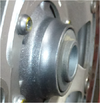It appears to me that some of you just keep questioning the instructions and measurements, and have stopped trying to figure out what has actually changed, or is actually causing the issues.
Your looking for the problems instead of the solutions.
Find the cause of the problem instead of throwing solutions at the problem etc.
Perhaps you should start searching for the cause, instead of questioning the cause.
People keep talking about the "set up", which side the spacers go, the gap, the way the forks move, etc.
We know all these things already, but what your searching for is why it is different for some reason.
Many things can cause these issues...
Were the bearings seated at the correct depth, or married too tightly against the inner wheel race (this will change a measurement)?
Are the dust seals over the bearings flattening out? (this will change a measurement)
Is the torque wrench used to tighten the axle correct, or has it been over tightening the axle, moving the bearing in too deep?
Is the end of the axle peened out and not sliding into the fork lower smoothly, pulling things out of measurement?
Is the hole in the end of the axle have a raised burr digging into the fork lower, dragging and pulling things out?
Are the wheel bearings OEM Honda, or have they ever been replaced with aftermarket cheaper bearings that may have different measurements?
Instead of fighting this with logic, trying to prove or disprove why it does not make any sense because the book measurements are such, take a step back, take a deep breath, and start really looking at things in detail, I'm sure you'll see something.


